Gennaro Cuofano's Blog, page 185
November 29, 2020
Lean Methodology Vs. Agile
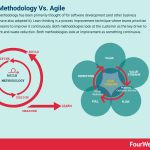
The Agile methodology has been primarily thought of for software development (and other business disciplines have also adopted it). Lean thinking is a process improvement technique where teams prioritize the value streams to improve it continuously. Both methodologies look at the customer as the key driver to improvement and waste reduction. Both methodologies look at improvement as something continuous.
[image error]Agile started as a lightweight development method compared to heavyweight software development, which is the core paradigm of the previous decades of software development. By 2001 the Manifesto for Agile Software Development was born as a set of principles that defined the new paradigm for software development as a continuous iteration. This would also influence the way of doing business.
[image error]The lean methodology is a continuous process of product development to meet customers’ needs. It was in part borrowed by the auto industry and its roots are found in the Toyota Production System, which was heavily influenced by Henry Ford’s assembly line system. The lean methodology is, therefore, an evolution from lean manufacturing, based on continuous improvement.
Read Next: Lean Canvas, Agile Project Management, Scrum, MVP, VTDF.
Main Guides:
Business ModelsBusiness StrategyMarketing StrategyBusiness Model InnovationPlatform Business ModelsNetwork Effects In A NutshellDigital Business Models
The post Lean Methodology Vs. Agile appeared first on FourWeekMBA.
Lean Methodology In A Nutshell
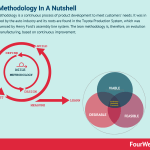
The lean methodology is a continuous process of product development to meet customers’ needs. It was in part borrowed by the auto industry and its roots are found in the Toyota Production System, which was heavily influenced by Henry Ford’s assembly line system. The lean methodology is, therefore, an evolution from lean manufacturing, based on continuous improvement.
A look into Kaizen and the roots of the Lean Methodology
[image error]Kaizen is a process developed by the auto industry. Its roots are found in the Toyota Production System, which was heavily influenced by Henry Ford’s assembly line system. The word Kaizen is a hybridization of two Japanese words, “kai” meaning “change” and “zen” meaning “good.” Two of the basic tenets of Kaizen involve making small incremental changes – or 1% improvement every day – and the full participation of everyone.
Kaizen is actually a process that developed out of the auto industry. Its most infamous roots are found in the Toyota Production System, which was heavily influenced by Henry Ford’s assembly line system.
In the 1930s a team from the Toyota Motor Company visited Henry Ford’s plant. At the time, Toyota was producing just 40 automobiles per day, while Ford was producing 8,000.
Toyota decided to implement many of Ford’s techniques, but a visit by one of the lead engineers to the local Piggly-Wiggly gave him an inspiration which significantly advanced the basics of Ford’s system.
Kaizen didn’t gain international popularity, however, until the 1980s when a Japanese organizational theorist and management consultant named Masaaki Imai founded the Kaizen Institute Consulting Group to help introduce the concepts of Kaizen to western businesses.
Quick Intro To Lean Thinking
In their book, Lean Thinking, James P. Womack, and Daniel T. Jones highlighted the key principles for lean thinking and the basis of the lean methodology. Lean Thinking, based on the study of the Toyota Production System, looked at five key guiding principles for process improvement, mainly focused on waste reduction: value, value streams, flow, pull and perfection.
Value: The lean thinking paradigm starts by defining value from the customer standpoint. Value can take many forms and shapes, and it can be a practical value (helping solving problems and pain points), perceived value (to establish status), or brand value (trust, switching costs). And this is the foundation of the lean thinking methodology. Value Streams: Once defined how the customer perceives value, it’s important to ma it out and identifies the stream, the steps the customer tasks to get that value, and how each step contributes to delivering it. Once identified the value streams, it is possible to identify the activities that add value to the customer and those that do not. And the latter need to be removed, as the lean methodology is a method of process improvement and, and foremost of waste reduction. Flow: Once the value stream has been improved to remove wastes and add only the activities that add value to the final customer, it’s important to check the flow and ensure that the whole value-creating process is smooth and in case reconfigure the steps taken by customers to in case enable that flow. Pull: Pull is all about avoiding wastes and have in place a just-in-time system, built from the ground up, on the customers’ needs. Perfection: This is what makes lean thinking a continuous, always evolving process, a process that looks at perfecting each step of the way, which requires continuous tweaking, feedback loop and revisiting of the various steps with which value is created and delivered.
Quick Intro to Agile And Lean Startup Movements
In 2001, a group of seventeen software developers met to discuss these lightweight development methods, with the aim of challenging the old assumption of heavyweight software development.
They forged “The Agile Alliance,” as a group of independent thinkers about software development, which agreed on the Manifesto for Agile Software Development.
[image error]Agile started as a lightweight development method compared to heavyweight software development, which is the core paradigm of the previous decades of software development. By 2001 the Manifesto for Agile Software Development was born as a set of principles that defined the new paradigm for software development as a continuous iteration. This would also influence the way of doing business.
[image error]Source: agilemanifesto.org
Steve Blank, launched the Lean Startup Movement, which as he explained in a 2013 HBR article “Why the Lean Start-Up Changes Everything:”
It’s a methodology called the “lean start-up,” and it favors experimentation over elaborate planning, customer feedback over intuition, and iterative design over traditional “big design up front” development.
Today startups take this methodology for granted. Yet at the time this was an innovation as Steve Blank recounted:
Although the methodology is just a few years old, its concepts—such as “minimum viable product” and “pivoting”—have quickly taken root in the start-up world, and business schools have already begun adapting their curricula to teach them.
[image error]
Some of the key aspects fo the lean startup movement is based on using a “scientific method” and a process of creating, launching and growing a startup.
This focuses on getting insights as quickly as possible from customers without focusing too much on business planning. As Steve Blank remarked in his 2013 article:
A business plan is essentially a research exercise written in isolation at a desk before an entrepreneur has even begun to build a product. The assumption is that it’s possible to figure out most of the unknowns of a business in advance, before you raise money and actually execute the idea.
Once the money is raised:
Developers invest thousands of man-hours to get it ready for launch, with little if any customer input. Only after building and launching the product does the venture get substantial feedback from customers—when the sales force attempts to sell it. And too often, after months or even years of development, entrepreneurs learn the hard way that customers do not need or want most of the product’s features.
In the lean startup movement and methodology, three things are critically important. In fact, those are the new pillars that challenged the old assumption of how an enterprise should look like have allowed the lean startup movement, thus the lean startup canvas.
On the HBR article Steve Blank remarks the waste of time a five-year business plan represents:
No one besides venture capitalists and the late Soviet Union requires five-year plans to forecast complete unknowns. These plans are generally fiction, and dreaming them up is almost always a waste of time.
Start-ups are not smaller versions of large companies
One of the critical differences is that while existing companies execute a business model, start-ups look for one
This point is critical because of a large organization or existing companies operating with known business models.
The lean startup instead iterates until it finds a business model that fits that startup. In fact, Steve Blank defines the lean startup as:
a temporary organization designed to search for a repeatable and scalable business model
It is crucial to emphasize the fact that the business model needs to be repeatable and scalable.
Toward Continuous Innovation In Business
[image error]That is a process that requires a continuous feedback loop to develop a valuable product and build a viable business model. Continuous innovation is a mindset where products and services are designed and delivered to tune them around the customers’ problem and not the technical solution of its founders.
[image error]The Continuous Innovation Mindset is a Manifesto proposed by Ash Maurya on blog.leanstack.com
Read Next: Lean Canvas, Agile Project Management, Scrum, MVP, VTDF.
Main Guides:
Business ModelsBusiness StrategyMarketing StrategyBusiness Model InnovationPlatform Business ModelsNetwork Effects In A NutshellDigital Business Models
The post Lean Methodology In A Nutshell appeared first on FourWeekMBA.
Agile Methodology In A Nutshell
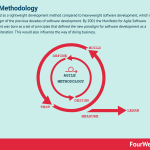
Agile started as a lightweight development method compared to heavyweight software development, which is the core paradigm of the previous decades of software development. By 2001 the Manifesto for Agile Software Development was born as a set of principles that defined the new paradigm for software development as a continuous iteration. This would also influence the way of doing business.
Quick Intro to the Agile Methodology
In 2001, a group of seventeen software developers met to discuss these lightweight development methods, with the aim of challenging the old assumption of heavyweight software development.
They forged “The Agile Alliance,” as a group of independent thinkers about software development, which agreed on the Manifesto for Agile Software Development.
Together they published the Manifesto for Agile Software Development. It comprises twelve guiding principles from which many applications (comprising Scrum) were born.
Our highest priority is to satisfy the customer through the early and continuous delivery of valuable software.Welcome changing requirements, even late in development. Agile processes harness change for the customer’s competitive advantage.Deliver working software frequently, from a couple of weeks to a couple of months, with a preference to the shorter timescale.Business people and developers must work together daily throughout the project.Build projects around motivated individuals. Give them the environment and support they need, and trust them to get the job done.The most efficient and effective method of conveying information to and within a development team is face-to-face conversation.Working software is the primary measure of progress.Agile processes promote sustainable development. The sponsors, developers, and users should be able to maintain a constant pace indefinitely.Continuous attention to technical excellence and good design enhances agility.Simplicity–the art of maximizing the amount of work not done–is essential.The best architectures, requirements, and designs emerge from self-organizing teams.At regular intervals, the team reflects on how to become more effective, then tunes and adjusts its behavior accordingly.
[image error]Source: agilemanifesto.org
Agile in Project Management
[image error]Agile project management (APM) is a strategy that breaks large projects into smaller, more manageable tasks. In the APM methodology, each project is completed in small sections – often referred to as iterations. Each iteration is completed according to its project life cycle, beginning with the initial design and progressing to testing and then quality assurance.
The APM framework is based on the Agile Manifesto which was originally written to guide software development. However, the four key values listed in the manifesto can be applied to almost any industry that has a focus on meeting consumer needs.
They are:
Individuals and interactions over processes and tools. In the face of advanced technology, the APM framework still recognizes the importance of human input.Working software over comprehensive documentation. When project teams avoid being bogged down by small, insignificant details, they can focus on delivering results.Customer collaboration over contract negotiation. Traditionally, customers are only involved at the beginning and end of project management. However, in APM the customer is involved with every step of the process to ensure their input is incorporated.Responding to change over following a plan. Agile project management works with change instead of actively trying to resist it. It emphasis creating a minimum viable product (MVP) at regular intervals as the process moves from iteration to iteration.
Agile In Software Development And Beyond
[image error]Scrum is a methodology co-created by Ken Schwaber and Jeff Sutherland for effective team collaboration on complex products. Scrum was primarily thought for software development projects to deliver new software capability every 2-4 weeks. It is a sub-group of agile also used in project management to improve startups’ productivity.
The Scrum elements
The Scrum methodology comprises three main components and a set of rules.
The Scrum Team
Within the team, there are three primary roles. It is important to remark that there is no hierarchy in the Scrum methodology. But each of the team members will be accountable for a specific part of the project.
The Product Owner: this person is primarily accountable for managing the completed increments of work.The ScrumMaster: this person does anything possible to help the team perform at the highest level.The Development Team: There are no titles in the Development Team. The main aim is to break down the product into items that can be incrementally implemented
Scrum Events (so-called Ceremonies)
The Sprint: 2-4 weeks period in which a specific part of the work is completedSprint Planning: those are meetings to assess which part of the product can be completedThe Daily Stand-up: it is a short meeting of no more than 15 minutes to evaluate the progress of the projectThe Sprint Review: a demonstration to present the work completed during the sprintThe Retrospective: final team meeting to assess what worked and what didn’t to improve the process
Scrum Artifacts
Product Backlog: outlines every requirement for a system, project or product. It can be a to-do list consisting of work itemsSprint Backlog: list of items to be completed during the sprintIncrement: is the list of items completed after the last software release
Scrum Rules
The team will define those rules according to the organization’s values and expectations. Thus there isn’t a simple set of rules to follow.
Agile in Business Design
[image error]A design sprint is a proven five-day process where critical business questions are answered through speedy design and prototyping, focusing on the end-user. A design sprint starts with a weekly challenge that should finish with a prototype, test at the end, and therefore a lesson learned to be iterated.
Design sprints are highly collaborative and experimental with a focus on the end-user. The approach is based on design thinking, which advocates a human-centered approach to innovation and rapid prototyping.
A typical design sprint follows this basic structure:
Monday – on the first day, the challenge is clearly identified and a strategy is devised for the rest of the week to overcome it. Who is the end-user and what are their needs?Tuesday – the sprint team brainstorms potential solutions and sketches various solutions that may have merit.Wednesday – from the list of solutions created on Tuesday, the team selects those that have a realistic chance of solving the problem by the end of the week. Then, each sketched solution is turned into a storyboard.Thursday – storyboards are turned into working prototypes that are ready for testing.Friday – on the last day, prototypes are shown to key stakeholders and tested for viability.
Agile for Startups
[image error]As pointed out by Eric Ries, a minimum viable product is that version of a new product which allows a team to collect the maximum amount of validated learning about customers with the least effort through a cycle of build, measure, learn; that is the foundation of the lean startup methodology.
Beyond Agile, and into Lean Methodologies
[image error]A leaner MVP is the evolution of the MPV approach. Where the market risk is validated before anything else
[image error]The lean startup canvas is an adaptation by Ash Maurya of the business model canvas by Alexander Osterwalder, which adds a layer that focuses on problems, solutions, key metrics, unfair advantage based, and a unique value proposition. Thus, starting from mastering the problem rather than the solution.
Tech Business Modeling
[image error]A tech business model is made of four main components: value model (value propositions, mission, vision), technological model (R&D management), distribution model (sales and marketing organizational structure), and financial model (revenue modeling, cost structure, profitability and cash generation/management). Those elements coming together can serve as the basis to build a solid tech business model.
Read Next: Lean Canvas, Agile Project Management, Scrum, MVP, VTDF.
Main Guides:
Business ModelsBusiness StrategyMarketing StrategyBusiness Model InnovationPlatform Business ModelsNetwork Effects In A NutshellDigital Business Models
The post Agile Methodology In A Nutshell appeared first on FourWeekMBA.
November 27, 2020
Elimination By Aspects Model In A Nutshell
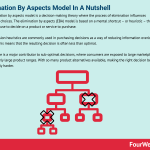
The elimination by aspects model is a decision-making theory where the process of elimination influences purchasing choices.
The elimination by aspects (EBA) model is based on a mental shortcut – or heuristic – that consumers use to decide on a product or service to purchase.
These decision heuristics are commonly used in purchasing decisions as a way of reducing information overload. However, this means that the resulting decision is often less than optimal.
E-commerce is a major contributor to sub-optimal decisions, where consumers are exposed to large marketplaces with similarly large product ranges. With so many product alternatives available, making the right decision becomes substantially harder.
An example of the elimination by aspects model
To understand how the elimination by aspects model works, consider it as a process.
First, a consumer browses a list of products with one attribute they deem essential. In the EBA model, attributes are simply product features. Products that do not contain this essential feature are excluded as potential purchases. A consumer looking to purchase a new car, for example, may deem that safety is the most important feature – thereby excluding any manufacturer except Volvo.With the shortened list of potential purchases, the consumer repeats the first step but with a different attribute. For example, the consumer may then search Volvo’s entire range for a car capable of accommodating four children.At this point, the range of potential cars has been shortened further. But the consumer also desires a safe, family-sized Volvo that has excellent fuel economy.Although many consumers may stop after three or four essential attributes, many others will continue until a single, “best fit” product remains
Ultimately, each product in the EBA model is judged based on its assortment or combination of product features. There is less emphasis on the product as a whole, provided that the product has the essential features a consumer desires.
Potential downsides to the elimination by aspects model
The elimination by aspects model is based on heuristic decision making as a means of bypassing information overload. As a result, the product a consumer eventually decides to purchase will be satisfactory – but not optimal.
This is because the model is non-compensatory, meaning that highly desirable attributes cannot compensate for less than desirable attributes. In the case of a new Volvo, cars were excluded in the third step based on fuel economy. However, a car slightly less economical on fuel may have delivered other benefits in reliability, servicing cost, and warranty. That is, benefits that would have compensated for the slight reduction in fuel economy.
Key takeaways
The elimination by aspects model is a mental shortcut that consumers use to make purchasing decisions when a large range of products are present.In the elimination by aspects model, a consumer progressively shortens a list of potential products according to whether they contain the right combination of desired features.The elimination by aspects model gives a satisfactory but non-optimal result. This is because the model does not make allowances for a desirable attribute being able to compensate for a non-desired attribute.
Main Guides:
Business ModelsBusiness StrategyMarketing StrategyBusiness Model InnovationPlatform Business ModelsNetwork Effects In A NutshellDigital Business Models
The post Elimination By Aspects Model In A Nutshell appeared first on FourWeekMBA.
Fast-And-Frugal Trees In A Nutshell

Fast-and-frugal trees are classification trees with sequentially ordered cues that aid in decision making. Fast-and-frugal trees (FFTs) are very simple illustrations of heuristic decision making. Each tree is comprised of sequentially ordered cues – or questions. In turn, each cue has two branches according to how the question can be answered:
If the answer to the question is yes, then the branch leads to the next question in the sequence.If the answer to the question is no, then the branch leads to an exit point in the sequence.
At the final cue in the sequence, both branches lead to an exit point to ensure that a decision is made either way.
Why is the fast-and-frugal tree useful in business?
Fast-and-frugal trees are particularly useful when decisions need to be made quickly. They are well suited to binary classification problems – or problems with elements occupying two possible outcomes.
FFTs have been trialed in emergency room scenarios to help physicians triage patients. During a peer-reviewed study, a classification tree of just three cues enabled doctors to diagnose and then direct patients to either a regular nursing bed or the coronary care unit.
Cues were based on historical acute heart disease data, allowing high-risk patients to be identified quickly and accurately. In fact, the process was so accurate that it was a better predictor of heart disease than the clinical judgment of the physicians themselves.
Constructing fast-and-frugal trees
There are several ways to construct fast-and-frugal trees.
In the emergency room example, physicians had historical data on factors that lead to acute heart disease. Chest pain was one such predisposition, leading to the creation of a cue entitled “Chest pain chief symptom?” with a yes or no answer.
Although FFTs were designed to be simple, they have nonetheless been adapted by using more complex methods. Primarily, this is seen in FFTs that are constructed using a zig-zag algorithm.
Here, the tree is created using positive and negative cue validity. This validity is defined as the proportion of cases with a positive/negative outcome in all cases with a positive/negative cue value. Typically, the first – or “root” – cue of a zig-zag analysis tree is the cue with the greatest positive (or negative) validity. This ensures that the most significant positive and negative decisions are made first.
Typically, cue validities are determined by using counts and ratios. In more advanced scenarios, they must be estimated using elements of probability theory such as conditional independence. Zig-zag decision trees enhance the already strong fundamentals of FFTs. Given that the tree can be completed with pen and paper, the accuracy of a zig-zag tree is as high as using a logistic regression model.
Fast-and-frugal tree applications
As noted, FFTs are useful in any situation requiring fast and accurate decisions or risk assessment.
Beyond medical applications, these trees have been used in the military to identify enemy threats and also in courtrooms to decide whether to bail or jail a defendant.
In recent times, fast-and-frugal trees have also shone a light on how customer management decisions are made. Retail banking sales managers who embodied fast, frugal, and adaptive decision making were able to better anticipate client needs.
Key takeaways:
Fast-and-frugal trees are heuristic models that are useful for tasks where binary decisions or classifications need to be made.Fast-and-frugal trees are made of sequentially ordered cues, otherwise known as questions. Each cue has a binary answer, with one answer leading to a subsequent question and the other leading to an exit point.Fast-and-frugal trees are simple and effective decision-making tools. However, the decision-making process is enhanced by using historical data and aspects of probability theory.
Read Next: Biases, Decision-Making, Bounded Rationality.
Main Guides:
Business ModelsBusiness StrategyMarketing StrategyBusiness Model InnovationPlatform Business ModelsNetwork Effects In A NutshellDigital Business Models
The post Fast-And-Frugal Trees In A Nutshell appeared first on FourWeekMBA.
Empathy Mapping In A Nutshell
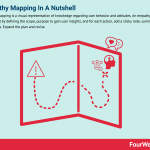
Empathy mapping is a visual representation of knowledge regarding user behavior and attitudes. An empathy map can be built by defining the scope, purpose to gain user insights, and for each action, add a sticky note, summarize the findings. Expand the plan and revise.
Understanding empathy mapping
Empathy mapping is based on the concept that a user will buy a product that meets their needs and not solely based on their wants.
To identify what those needs are, empathy maps are created to help businesses gain a deeper understanding of the people they are trying to serve. With this information, buyer personas can be developed to develop and then target elements of broader user stories.
Traditional empathy maps contain four quadrants. Each provides a holistic assessment of four key user traits:
Says – what has the user said out loud? Use verbatim or directly quoted information wherever possible.Thinks – consider the thoughts that run through the user’s mind. What is important to them? What challenges are they facing? Sometimes the user will be reluctant to share things that are bothering them, so prior qualitative research is required.Does – encompassing any action the user takes. For an e-commerce company, a particular user may repeatedly add a product to their shopping cart without purchasing it.Feels – often based on emotions. What worries or excites them? A user may be overjoyed at buying a product on sale but then experience frustration upon not being able to learn how to use it.
Creating an empathy map
To create an empathy map, businesses should follow these steps:
Define the scope. Will the map be representative of a buyer persona or an individual user?Define the purpose. If the goal is to align the whole company, then every team member should be involved. However, if the focus is on qualitative research then only suitably skilled individuals should be approached.Gain user insights. Interviews, surveys, and field studies are a good place to start.Write each action on a sticky note based on insights gleaned from the previous step. Team members should work collaboratively to group similar sticky notes according to each quadrant. Summarise the findings. Were there any actions that did not fit any quadrant? Were there common themes or conversely, themes that occurred rarely? What does prevalence or a lack thereof say about potential gaps in user understanding?Expand, plan, and revise. In some cases, businesses will need to add further quadrants to accommodate gaps in their knowledge. “Goals” and “Pains” are two examples of extra quadrants that are used in empathy mapping. Once a final map has been created, it should be digitized and distributed to relevant employees. It should also be noted that empathy mapping is an iterative process. Plan to revisit and update maps periodically when new insights are identified.
Empathy mapping best practices
Empathy mapping is a collaborative effort, so it is perhaps inevitable that disagreements will occur regarding where actions should be assigned. Each team member may categorize information differently according to their personal values or experiences.
Remember that the goal with empathy mapping is to identify and connect with the user. Much less importance is placed on accurately classifying information into each quadrant.
Furthermore, ensure that the mapping process does not include extraneous information. Businesses should only perform and incorporate qualitative research that directly relates to how a user interacts with their products or services.
Key takeaways
Empathy mapping is a visualization process that helps businesses understand what their users want out of products Empathy mapping involves the analysis of four quadrants: says, thinks, does, and feels. Together, the four quadrants give a holistic view of how a user interacts with a product or service.To get the most out of empathy mapping, businesses should focus on identifying with the user by incorporating a broad suite of team member perspectives. While the quadrants are important delineations, teams can lose sight of the end goal by debating minute details.
Main Guides:
Business ModelsBusiness StrategyMarketing StrategyBusiness Model InnovationPlatform Business ModelsNetwork Effects In A NutshellDigital Business Models
The post Empathy Mapping In A Nutshell appeared first on FourWeekMBA.
Customer Experience Map In A Nutshell
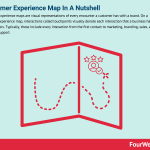
Customer experience maps are visual representations of every encounter a customer has with a brand. On a customer experience map, interactions called touchpoints visually denote each interaction that a business has with its consumers. Typically, these include every interaction from the first contact to marketing, branding, sales, and customer support.
Understanding a customer experience map
Inevitably, not every interaction that a customer has with a brand will be positive. Perhaps they added a product to their shopping cart that wasn’t in stock. Perhaps after-sales technical support was severely lacking or customer service representatives were rude and uninformed.
Whatever the cause, a customer experience map allows businesses to improve every aspect of its customer interactions. In turn, this leads to satisfied customers who are more likely to become loyal, devoted followers.
Creating a customer experience map
A customer experience map may be created using sticky notes, spreadsheets, or elaborate flow charts to represent various touchpoints.
However, it’s important that the focus is on functionality and not design. The data should be organized in such a way that it demonstrates the customer progression from the first contact to making a purchase and beyond. It should also detail where the business is excelling in the process and standards are sub-par.
To that end, feedback should be gathered from customers and employees. Then, consider these elements of a successful customer experience map:
Touchpoint inventory – list every conceivable way a customer is touched by the business. This includes digital and print media, advertisements, sales representatives, telemarketing, and bricks and mortar stores.Point of relationship – at each of the predetermined touchpoints, consider where the customer is in their buying journey. How does the business present itself when the customer is gathering information before making a purchasing decision? How does it position itself to satisfied or loyal customers who are likely to become advocates?Business reason – from an operations perspective, consider the reasons for each touchpoint existing. Is the goal to educate, inspire, inform, provide support, or receive payment?Customer impact – from a customer perspective, again consider the reasons for each touchpoint existing. Reasons may encompass market differentiation, loyalty-building, or the encouragement of repeat sales.Touchpoint owner – who is responsible for managing each touchpoint?Effectiveness – or the ability of a touchpoint to provide a positive or negative experience for the customer. Businesses must think deeply about whether they are meeting customer expectations at every touchpoint. If not, superfluous interactions should be removed or standards improved.
Customer experience map benefits
The most obvious benefit of customer experience mapping is happier customers and increased sales.
However, the process also allows a business to:
Improve marketing campaigns. By identifying a customer’s specific pain points, marketing teams can relate to their customers on a personal level and work toward solving their problems.Improve customer retention. Given that customer experience mapping continues after the purchase has been made, businesses can refine their after-sales retention strategies to maximum effect. This increases Net Promoter Score (NPS) – or the likelihood of a consumer recommending a business to friends or family.Facilitate proactive customer service. Many of the negative interactions a customer has with a brand are related to poor customer service. Businesses who understand this are seen as more empathetic and sensitive to customer needs. They can also anticipate customer needs in periods of high demand during holidays and sales – and roster staff accordingly.
Key takeaways
A customer experience map is a visual representation and assessment of business-to-customer relationships at every stage of the buying journey.In creating a customer experience map, function is more important than form. The map must clarify touchpoints where a business is either strengthening or weakening the quality of the interaction.Customer experience maps are important in developing buyer personas and building personable relationships with consumers. With a focus on proactively addressing common pain points, customer loyalty and retention increases.
Main Guides:
Business ModelsBusiness StrategyMarketing StrategyBusiness Model InnovationPlatform Business ModelsNetwork Effects In A NutshellDigital Business Models
The post Customer Experience Map In A Nutshell appeared first on FourWeekMBA.
Communication Cycle In A Nutshell
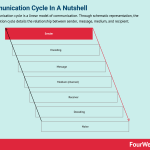
The communication cycle is a linear model of communication. Through schematic representation, the communication cycle details the relationship between sender, message, medium, and recipient.
Understanding the communication cycle
The communication cycle was developed by mathematicians Claude Elwood Shannon and Warren Weaver.
In any context, effective communication is the conveying and receiving of messages between individuals in a manner that is easily understood. The process of communication starts when a sender transmits a message to a receiver through a specific medium. Upon receiving the message, the receiver responds in an appropriate time frame – otherwise known as feedback. This simple back and forth example where the sender and receiver reciprocate roles represents the communication cycle.
The cycle can be used when messages are transmitted through writing or non-verbal (body language) means in a variety of different contexts.
Components of the communication cycle
In Shannon and Weaver’s interpretation, there are seven components to the cyclical process of communication.
Sender
The sender – otherwise known as the source – starts the cycle by deciding they have information they want to share. Before sending a message, the sender must ensure that it reaches the receiver in a way that the receiver understands. In other words, what is the purpose of the message? How should the receiver ideally react after receiving the message?
Encoding
Encoding involves the sender deciding on how to best convey their message. Appropriate words, gestures, tones, and sounds are important and should be based on knowledge of the receiver. For example, authors who write children’s books usually communicate in short, sharp sentences with simple, child-friendly words.
Message
The message is simply the piece of information a sender communicates. Messages are based on the information chosen and how the information is conveyed so that the receiver understands it.
Medium (channel)
The medium describes the means of communication. It may be a newspaper, computer screen, television, or radio. Each medium will be suited to a particular form of communication and subsequent audience.
Receiver
The receiver is an important part of the communication cycle, for without someone to receive a message there can be no sender.
The receiver gathers sent information and then attempts to understand it. If successful, the receiver becomes the sender, and the cycle repeats. This is also known as feedback because the receiver responds to a message by broadcasting their views.
Decoding
To ensure that the process runs effectively, messages must easily be decoded. For example, a video featuring Stephen Hawking communicating the wonders of astrophysics would be lost on most children. A travel article espousing the nuanced beauty of a particular destination may be unable to be communicated to readers who have never visited. Indeed, successful receiver decoding is often reliant upon individual thoughts, memories, and perspectives.
Noise
Invariably, there will be interferences in the communication cycle. This is called noise, which disrupts harmonious communication in several ways.
Noise can occur when the sender uses technical jargon in their messages that the receiver cannot understand. Those who speak with heavy accents may also experience problems with communication. The receiver can also contribute to noise. Distractions are common in this instance, perhaps the result of being ill or entering a communication with preconceived notions or judgments.
Lastly, noise can also be literal. Loud concerts are notorious for contributing to poor communication, as are slow internet connection speeds.
Key takeaways
The communication cycle describes the cyclical relationship in communication between a receiver and sender.In Shannon and Weaver’s interpretation, the communication cycle is based on seven core components. The communication cycle argues that effective communication relies on clear and accurate messaging easily interpreted and understood by each party. In any case, noise can contribute to ineffective communication through distortions in encoding and decoding among other things.
Main Guides:
Business ModelsBusiness StrategyMarketing StrategyBusiness Model InnovationPlatform Business ModelsNetwork Effects In A NutshellDigital Business Models
The post Communication Cycle In A Nutshell appeared first on FourWeekMBA.
COSO Framework In A Nutshell
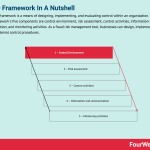
The COSO framework is a means of designing, implementing, and evaluating control within an organization. The COSO framework’s five components are control environment, risk assessment, control activities, information and communication, and monitoring activities. As a fraud risk management tool, businesses can design, implement, and evaluate internal control procedures.
Understanding the COSO framework
According to the Association of Certified Fraud Examiners, weak internal control is the cause of almost 50% of all company fraud.
To develop a strong and effective internal control system, the COSO framework was created by the Committee of Sponsoring Organizations of the Treadway Commission (COSO). The committee is comprised of representatives from various industries, including accounting, finance, and auditing.
Collectively, the committee develops procedural guidance that assists businesses with risk assessment. In so doing, internal controls are strengthened to reduce the likelihood of fraud.
What constitutes internal control? How is it defined?
The COSO framework states that internal control is a “process effected by an entity’s board of directors, management and other personnel designed to provide reasonable assurance of the achievement of objectives” under the following categories:
Operational effectiveness and efficiency. This includes performance goals and securing assets against potential fraud. Financial reporting liability – whether that be internally or externally. Transparency, punctuality, and reliability are vital.Legal and regulatory compliance.
The five components of the COSO framework
Five components work together to deliver an effective internal control system while supporting the vision, goals, or objectives of the business concerned.
Let’s take a look at each in more detail.
1 – Control Environment
This encompasses the standards or processes that dictate internal control across an organization. Typically, upper management will set the tone regarding the importance of establishing and then maintaining internal control. This creates an environment that attracts, develops, and then retains talented individuals. There is also accountability in performance and rewards and incentives are routinely given where appropriate. To some extent, the control environment also extends to ethical values and organizational structure.
2 – Risk assessment
Every business deals with risk, but not all deal with risk effectively. Those with robust internal control will assess each risk according to the level of the threat to company objectives and established risk tolerances.
Importantly, businesses must consider internal and external risks that can weaken internal control.
3 – Control activities
Once risks have been identified, policies and procedures must be devised to mitigate against them. These so-called “control activities” must be implemented across the organization to help it achieve stated goals without taking unnecessary risks.
Here, internal control is maintained by authorizations, approvals, verifications, and performance reviews. If possible, employee duties should also be segregated commensurate with experience or skill level.
4 – Information and communication
COSO framework principles help ensure that all internal and external communications adhere to company procedures and further company objectives. Information must also be disseminated only when appropriate. For example, a new policy should be communicated to every employee in the organization. However, share price sensitive information should be confined to upper management until released to the market.
5 – Monitoring activities
Monitoring controls is just as important – if not more important – than establishing them. Periodic evaluation should be incorporated into all business practices to ensure that controls are being maintained.
Externally, financial reporting is a particularly important in deterring fraud.
Key takeaways
The COSO framework is a fraud risk management tool that businesses use to design, implement, and evaluate internal control procedures.The COSO framework guides the best practices for operational effectiveness, financial reporting, and legal or regulatory compliance.The COSO framework has five core components. In combination, each allows a business to maintain internal control without sacrificing the ability to meet goals or uphold company values.
Main Guides:
Business ModelsBusiness StrategyMarketing StrategyBusiness Model InnovationPlatform Business ModelsNetwork Effects In A NutshellDigital Business Models
The post COSO Framework In A Nutshell appeared first on FourWeekMBA.
Decoy Effect In A Nutshell
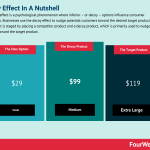
The decoy effect is a psychological phenomenon where inferior – or decoy – options influence consumer preferences. Businesses use the decoy effect to nudge potential customers toward the desired target product. The decoy effect is staged by placing a competitor product and a decoy product, which is primarily used to nudge the customer toward the target product.
Understanding the decoy effect
Price is one of the most sensitive elements of a marketing mix. Businesses understand this well and have devised pricing strategies that encourage the consumer to spend more.
The decoy effect is one such strategy. To study how consumer product preferences are influenced by the effect, National Geographic studied the popcorn purchasing habits of cinemagoers.
When faced with only two choices – a $3 small popcorn or a $7 large popcorn – most purchased the small popcorn noting that the large was too expensive.
The experiment was then repeated with the addition of a $6.50 medium popcorn, and the consumers were again asked to choose. This time, most chose the large $7 option. By adding the medium-sized alternative, greater value was given to the larger size which was previously deemed too expensive.
In the context of the decoy effect, the medium $6.50 popcorn was the decoy because it was inferior to the larger option in value for money. Decoys are deliberately inserted into product ranges to exploit consumer tendencies toward prioritizing value for money.
In dollar terms, the cinema was able to increase revenue by directing consumers from the small $3 option to the most expensive $7 option. The consumer, however, is more likely to spend money on a product or service they didn’t want or need.
Components of the decoy effect
The decoy effect is based on the concept of asymmetric domination, most evident when a consumer has three products or services to choose from. To explain this concept in more detail, let’s give each product a name:
The target product – or the product that a business wants to you purchase.The competitor product – or the product that competes with the target.The decoy product – or the product designed to nudge a consumer toward the target product.
The decoy effect relies on the decoy product being asymmetrically dominated by the target and competitor product in at least two categories. In the popcorn example, the two categories are price and size. The study was successful because the medium popcorn was a decoy that was asymmetrically dominated.
In other words, the medium popcorn:
Contained more popcorn than the small size while being more expensive. As a result, it was only partially superior to the small size.Contained less popcorn than the large size, but given that it was only 50 cents cheaper, represented less value for money than the large size.
Here, the decoy (medium) size is inserted to make the larger size more attractive. It is not inserted to make the smaller size more attractive, making the dominance asymmetrical.
Applying the decoy effect in marketing
Marketers can use the decoy effect to their advantage and happily, research has found that consumer awareness of the effect does not diminish their tendency to choose the most expensive option.
Companies that offer tiered pricing or subscription plans are most likely to benefit from inserting decoys into their ranges.
Hosting companies can offer a feature-packed “Platinum” hosting plan that is only slightly more expensive than a lesser equipped “Gold” plan. Coffee shops can offer large coffees closer in price to medium coffees. In real estate, the value of a particular house can be highlighted by comparing it against two similarly priced houses with fewer features occupying less favorable neighborhoods.
Key takeaways:
The decoy effect is a phenomenon where consumers change preference between two product options when a third product option is made available.Marketers use the decoy effect to direct consumers to the product they want them to purchase. This is achieved through asymmetric domination, where a decoy product makes just one of the two remaining products attractive.The decoy effect has almost limitless applications in business and marketing. However, it is most effective where tiered product ranges or subscription services are offered.
Main Guides:
Business ModelsBusiness StrategyMarketing StrategyBusiness Model InnovationPlatform Business ModelsNetwork Effects In A NutshellDigital Business Models
The post Decoy Effect In A Nutshell appeared first on FourWeekMBA.



